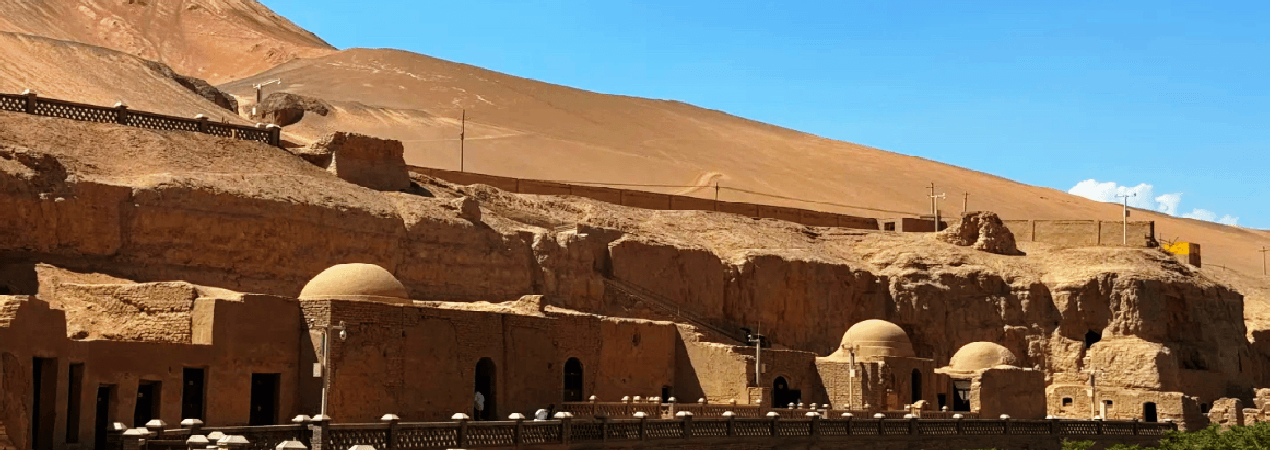Bezeklik Thousand Buddha Caves

The Bezeklik Thousand Buddha Caves are the grotto complex with the largest number of existing caves and the richest mural content in Turpan, and one of the most famous Buddhist heritage sites preserved in Xinjiang. The Bezeklik Thousand Buddha Caves currently have 83 existing caves, among which more than 40 retain murals. The mural area exceeds 1,200 square meters, mainly featuring Buddhist murals. The murals can be roughly divided into three periods: the Qu's Gaochang period (499–640), the Tang Xizhou period (640–790) and the Gaochang Uyghur Kingdom period (approximately 866–1209). The murals from the Gaochang Uyghur Kingdom period are the most abundant in content.
- Chinese name: 柏孜克里克千佛洞 Bǎi zī kè lǐ kè Qiān fó Dòng
- Suggested time: 1 - 2 hours
- Ticket: 40 yuan per person
- Open hours: 9:00 - 19:00
- The best time to visit: Spring (March - May) and autumn (September - November)
- Address: 5 kilometers north of Flaming Mountains Scenic Area, Gaochang District, Turpan, Xinjiang
- How to get there: Renting a car or taking a taxi is a convenient option. It takes about an hour's drive from the city center of Turpan.
- Surroundings: Flaming Mountains, Mutougou Valley
Highlights of Bezeklik Thousand Buddha Caves
Murals from the Qu's Gaochang Kingdom Period
Caves 18, 29, and 48 date back to the Qu's Gaochang Kingdom Period. Cave 18, a large central pillar grotto, is the earliest cave in the complex with clearly visible murals. The front chamber, corridor, and lower part of the tunnel were repainted in the early period of the Gaochang Uyghur Kingdom, while only the upper part and ceiling of the tunnel perfectly preserve the early mural contents—specifically, the "Dou Si" (four-square) ceiling patterns and thousands of Buddhas painted on the side walls, all wearing round-collar full-shoulder kasayas with vivid details.
Murals from the Tang Xizhou Period
Caves 16, 17, 25, 27, 31, 42, and 69 date back to the Tang Xizhou Period. A considerable number of these caves were repainted after the 11th century. The mural themes of this period mainly feature large-scale sutra illustration paintings originating from the Central Plains.
Murals from the Gaochang Uyghur Period
The Bezeklik Grottoes boast the richest remains from the Gaochang Uyghur Period. Typical caves of this era include Caves 14, 20, 31, 33, 39, 41, 82, etc. The mural themes are more diverse than before, featuring various Buddhas, Bodhisattvas in myriad postures, large-scale sutra illustration paintings, preaching scenes, thousands of Buddha figures, processions of Bodhisattva devotees, deities of the Eight Classes of Divine Beings and Four Heavenly Kings, portraits of donors and monastic devotees, as well as various decorative patterns. Additionally, jataka stories (karma tales) appear, depicting how the Bodhisattva sincerely worshiped Buddhas through countless past lives before attaining enlightenment—these are well worth exploring.
Educational Value
The Bezeklik Thousand Buddha Caves, first built in the Northern and Southern Dynasties and flourishing during the Gaochang Uyghur Kingdom (9th-13th centuries), stand as a typical representation of the integration of Buddhist art and multi-ethnic cultures along the Silk Road. The murals, statues, and architectural remains in the caves vividly demonstrate the fusion of diverse artistic styles from the Central Plains, Western Regions, Gandhara in India, and the Uyghur people.
Activities to do at Bezeklik Thousand Buddha Caves
Historical Architecture Photography: Take photos of the cliff landscape and rammed-earth architectural contours of the cave complex in designated areas, capturing the texture of loess walls in morning and evening light to showcase the vicissitudes of the Silk Road ruins. (Comply with cultural heritage protection regulations; flash photography is prohibited.)
Architectural Technique Experience: Try the rammed-earth construction craftsmanship, using local clay and wheat straw to simulate the process of building cave walls, and appreciate the wisdom of ancient craftsmen.
Drop us a line and we'll connect you with the top China expert in no time!